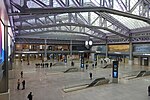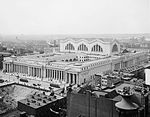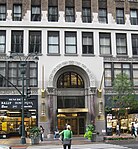Hulu Theater
1968 establishments in New York CityConcert halls in New York CityDel E. Webb buildingsEvent venues established in 1968Former Viacom subsidiaries ... and 7 more
Grammy Award venuesHuluMadison Square GardenMadison Square Garden SportsMusic venues in ManhattanPennsylvania PlazaTheatres in Manhattan

The Hulu Theater at Madison Square Garden is a theater located in New York City's Madison Square Garden. It seats between 2,000 and 5,600 for concerts and can also be used for meetings, stage shows and graduation ceremonies. No seat is more than 177 feet (54 m) from the 30-by-64-foot (9.1 by 19.5 m) stage. Since it is located beneath the main Madison Square Garden arena, the theater has a relatively low 20-foot (6.1 m) ceiling at stage level and all of its seating except for boxes on the two side walls is on one level slanted back from the stage. There is an 8,000-square-foot (740 m2) lobby at the theater.
Excerpt from the Wikipedia article Hulu Theater (License: CC BY-SA 3.0, Authors, Images).Hulu Theater
Pennsylvania Plaza, New York Manhattan
Geographical coordinates (GPS) Address Phone number Website Nearby Places Show on map
Geographical coordinates (GPS)
| Latitude | Longitude |
|---|---|
| N 40.75063 ° | E -73.993744 ° |
Address
Madison Square Garden (The Garden)
Pennsylvania Plaza 4
10001 New York, Manhattan
New York, United States
Open on Google Maps






